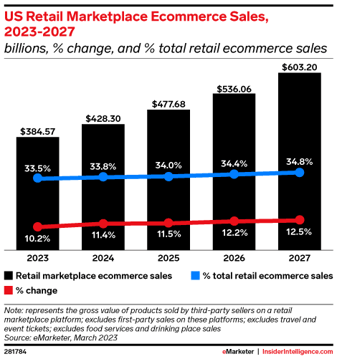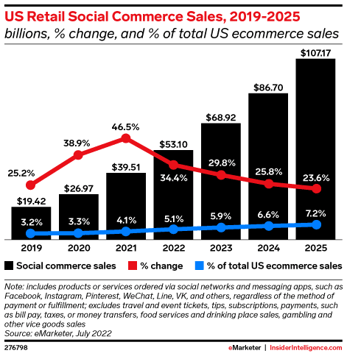As the eCommerce realm continues to grow and thrive, you might find yourself asking “What’s the best channel for my brand?” With seemingly endless eCommerce channels available, ranging from online marketplaces to social media platforms and standalone websites, choosing the right ones for your brand can be a daunting task. However, once you’re able to develop a strong multichannel strategy for your brand, you can see strong growth and returns on your investment.
This foundational understanding of your brand and target audience serves as the compass guiding your strategy. Start by examining your brand’s identity – its values, personality, and mission. What sets your brand apart from competitors? Identifying your differentiators is essential; it could be the quality of your products, your commitment to sustainability, exceptional customer service, or innovative solutions to common problems. Understanding these will help you communicate your brand’s value proposition effectively across all eCommerce channels.
Next, delve into your product offerings. What are your flagship products or services? How do they meet the needs and desires of your target audience? Consider the lifecycle of your products, their pricing strategy, and how they fit into the broader market landscape.
Now, let’s turn our attention to your target audience. Who are they? What are their demographics – age, gender, location, income level, etc.? A study that Hubspot conducted found that only 42% of marketers know basic demographic information of their target audience. By spending time getting to know who you want to sell to, your brand will have a much stronger voice and presence online, leading to greater growth and sales. Beyond demographics, delve into their psychographics – their interests, values, lifestyle preferences, and pain points. Understanding the motivations and aspirations driving their purchasing decisions will enable you to tailor your messaging and offerings to resonate with them effectively.
Furthermore, analyze their shopping behaviors. Where do they prefer to shop online? Are they more inclined towards convenience, seeking out the best deals, or valuing personalized experiences? By understanding their preferred shopping channels, whether it’s browsing on social media, searching on search engines, or exploring niche marketplaces, you can strategically allocate resources to the most relevant eCommerce platforms.
By synthesizing insights into your brand identity, product offerings, and the demographics, preferences, and shopping behaviors of your target audience, you can pinpoint the eCommerce channels that align most closely with your brand’s objectives and audience’s preferences. This holistic understanding will inform your channel selection and empower you to craft a tailored eCommerce strategy that maximizes reach, engagement, and conversion opportunities.
 to reach a broad audience of online shoppers. These marketplaces can be a great place to grow your brand, as they provide built-in traffic, credibility, and trust, making them attractive options for brands looking to expand their reach quickly. In fact, retail marketplace eCommerce sales are expected to reach $428.3 billion in 2024, and continue growing through 2027, as seen in the graph to the right. However, competition can be fierce, and brands may face challenges in standing out among the multitude of listings. When considering online marketplaces, evaluate factors such as fees, competition level, and the platform’s policies regarding branding and customer communication.
to reach a broad audience of online shoppers. These marketplaces can be a great place to grow your brand, as they provide built-in traffic, credibility, and trust, making them attractive options for brands looking to expand their reach quickly. In fact, retail marketplace eCommerce sales are expected to reach $428.3 billion in 2024, and continue growing through 2027, as seen in the graph to the right. However, competition can be fierce, and brands may face challenges in standing out among the multitude of listings. When considering online marketplaces, evaluate factors such as fees, competition level, and the platform’s policies regarding branding and customer communication. TikTok Shop, Instagram Shopping, and Facebook Marketplace, enabling brands to sell directly to their followers. There are currently 96.9 million social shoppers in the United States alone, and this figure is expected to continue growing. Social commerce leverages the visual and interactive nature of social media to engage audiences and drive conversions. The social commerce market in the United States is expected to reach $107.17 billion by the end of 2025, as can be seen in the graph to the right, so there’s never been a better time to explore this channel for your brand.When exploring social commerce options, consider the platform demographics, engagement level, and the suitability of your products for social selling. Additionally, invest in creating compelling visual content and leveraging social media advertising to maximize your reach and engagement.
TikTok Shop, Instagram Shopping, and Facebook Marketplace, enabling brands to sell directly to their followers. There are currently 96.9 million social shoppers in the United States alone, and this figure is expected to continue growing. Social commerce leverages the visual and interactive nature of social media to engage audiences and drive conversions. The social commerce market in the United States is expected to reach $107.17 billion by the end of 2025, as can be seen in the graph to the right, so there’s never been a better time to explore this channel for your brand.When exploring social commerce options, consider the platform demographics, engagement level, and the suitability of your products for social selling. Additionally, invest in creating compelling visual content and leveraging social media advertising to maximize your reach and engagement.Choosing the right eCommerce channels for your brand requires careful consideration of your brand identity, target audience, and business objectives. By understanding the strengths and limitations of each eCommerce channel and aligning them with your brand’s goals, you can create a cohesive and effective multichannel eCommerce strategy. Regardless of the channel or combination of channels that you choose to utilize, be sure to prioritize consistency, engagement, and customer satisfaction to drive long-term success in the eCommerce world.
More About aiCommerce
aiCommerce is a global digital marketing agency with a focus on retail and eCommerce marketplaces. Started by three digital marketing experts, aiCommerce is primed with decades of digital marketing experience and backed by our 90-day grow and know guarantee, we can help your brand grow across eCommerce channels to gain brand awareness and increase sales! Now is the perfect time to utilize our eCommerce experts to help grow your business.